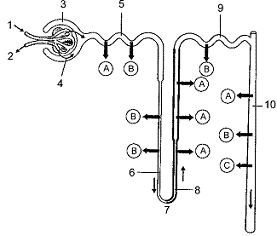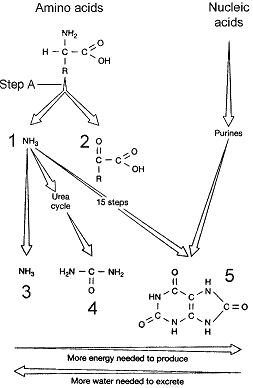A) renal pyramids.
B) Bowman's capsules.
C) distal convoluted tubules.
D) glomeruli.
E) proximal convoluted tubules.
Correct Answer

verified
Correct Answer
verified
Multiple Choice
Figure 48-3

Refer to the accompanying figure. In which regions does atrial natriuretic peptide act?
Refer to the accompanying figure. In which regions does atrial natriuretic peptide act?
A) 3 and 10
B) 5 and 6
C) 2 and 66
D) 1 and 9
E) 9 and 10
Correct Answer

verified
Correct Answer
verified
True/False
Blood flows from the efferent arterioles directly into the peritubular capillaries.
Correct Answer

verified
Correct Answer
verified
Matching
Match the part of the human urinary system with its description.
Correct Answer
Matching
Match the waste product with its description or the animal that excretes it.
Correct Answer
Multiple Choice
Marine cartilaginous fishes overcome water loss to their environments by
A) having specialized chloride cells in their gills that prevent water loss.
B) having specialized chloride cells in their gills that continuously excrete salts.
C) storing urea in their body fluids, which causes them to be hypertonic to sea water.
D) producing very small quantities of urine.
E) drinking large quantities of freshwater.
Correct Answer

verified
Correct Answer
verified
Multiple Choice
In the morning, urine tends to be concentrated because _______ secretion of ADH _______.
A) liver; increases
B) heart; decreases
C) pituitary gland; increases
D) pituitary gland; decreases
E) thyroid gland; increases
Correct Answer

verified
Correct Answer
verified
Multiple Choice
Figure 48-1

The process represented at step A of the accompanying figure is referred to as
The process represented at step A of the accompanying figure is referred to as
A) filtration.
B) secretion.
C) excretion.
D) deamination.
E) elimination.
Correct Answer

verified
Correct Answer
verified
Essay
Compare and contrast osmoregulation of freshwater fish and marine fish.
Correct Answer

verified
Freshwater fishes live in a hypotonic en...View Answer
Show Answer
Correct Answer
verified
View Answer
Matching
Match the waste product with its description or the animal that excretes it.
Correct Answer
Multiple Choice
The ascending limb of the loop of Henle is more permeable to ____ than to _____.
A) water; urea
B) water; salt
C) salt; water
D) salt; urea
E) urea; salt
Correct Answer

verified
C
Correct Answer
verified
Multiple Choice
The main osmoregulatory and excretory organ in most vertebrates is the
A) skin.
B) gill.
C) metanephridium.
D) lung.
E) kidney.
Correct Answer

verified
E
Correct Answer
verified
True/False
Birds store most of their waste nitrogen as uric acid.
Correct Answer

verified
Correct Answer
verified
Multiple Choice
The ureters connect the
A) bladder to the body exterior.
B) kidney to the bladder.
C) bladder to the urethra.
D) kidney to the body exterior.
E) kidney to the urethra.
Correct Answer

verified
Correct Answer
verified
Multiple Choice
Secretion occurs mainly in the
A) distal convoluted tubule.
B) loop of Henle.
C) proximal convoluted tubule.
D) collecting duct.
E) glomerulus.
Correct Answer

verified
Correct Answer
verified
Matching
Match the term below with its definition/description.
Correct Answer
Essay
Discuss why a doctor would prescribe an ACE inhibitor to a patient with a history of high blood pressure.
Correct Answer

verified
Concepts to Consider: ACE is an enzyme i...View Answer
Show Answer
Correct Answer
verified
View Answer
Multiple Choice
The main point of entry of water into the blood of freshwater fish is through the
A) skin.
B) gills.
C) tail.
D) anus.
E) eyes.
Correct Answer

verified
Correct Answer
verified
Matching
Match the excretory structure with its description or animal.
Correct Answer
Matching
Match the excretory structure with its description or animal.
Correct Answer
Showing 1 - 20 of 111
Related Exams